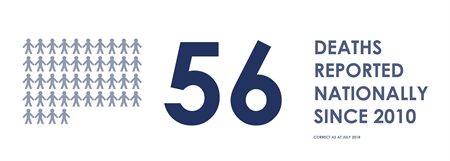As part of the SFRS Older People Month of Action the fire and rescue service are highlighting the fact that Emollient Creams (skin care products used to treat conditions including eczema and bed sores) can create a potential fire hazard for users.
A recent report from the National Fire Chief’s Council (NFCC) estimated that “1 in 5 children and 1 in 12 adults suffer from eczema at some point in their lives and 2-3% of the population suffer from psoriasis.”
One of the most effective and commonly prescribed treatments for these conditions is the regular application of emollient skin care products.
Additionally, many people use emollients for the treatment of bed sores and other sores which develop as a result of restricted mobility or immobility.
Most emollients contain some level of paraffin.
When creams which contain paraffin soak into fabrics such as clothing, dressings and bedding and an ignition source is introduced, a fire is likely to occur and will burn more rapidly and hotter than it would if the fabric had not been contaminated, leaving very little time to react.
SFRS Director of Prevention and Protection, Assistant Chief Officer Ross Haggart said: “We want people to check if the product they are using contains paraffin. If it does then the safety steps we are outlining really are essential.
“The data we currently have shows that where people have died in fires involving emollient creams the casualties have all been aged 60 and over.
“The majority were also smokers and had restricted or significantly limiting mobility issues and/or a care plan in place.
“Since 2010 it is estimated that over 50 people in the UK have lost their lives due to fires involving emollient creams. The true figure may be higher as emollients are not currently identified on the national Incident Reporting System.
“As a Service we recognise that this is an area where further research may be required, but we want to take action now.
“If you use emollient creams, or know or care for someone who does – you may be a friend, relative, carer or a professional working for a care provider – I would urge you to follow our safety tips.
- Do not smoke if you are wearing clothing or near bedding which has been in contact with emollient cream
- Ensure clothing, bedding or towels which have been in contact with emollient creams are washed frequently at high temperatures
- Check to see if the cream you are using contains paraffin. Some creams may already show a fire risk warning
- Ask a health professional if an alternative cream which does not contain paraffin is available
ACO Haggart added: “The National Fire Chief’s Council have proposed further research regarding emollient creams and we will continue to closely monitor developments.
“Many people are unaware of the potential risks involving emollient creams and are possibly also still unaware of the increased risk of dying in a fire which older people face.
“This Month of Action is intended to highlight these risks and to provide positive solutions. Every accidental fire death is a tragedy.
“We will continue to work to save lives, to prevent these tragedies.”
The following statistics are provided by the NFCC Emollients working group (May 2019).
Since 2010 in the UK, more than 50 people have died, 2 sustained serious injuries and 9 have been evacuated1 from a residential care home, in incidents where fabric, which has been contaminated with emollient, has been ignited by a flame or other ignition source and has burnt rapidly and intensely.
Current data, gathered from fire and rescue services and the MHRA2 shows there have been 58 cases identified (56 fatalities and 2 serious injuries). Actual figures are likely to be significantly higher, but emollients are not currently identified on the national Incident Reporting System. Of the 58 cases, 46 (79%) people were identified as smokers, 8 were non-smokers and 4 people were smoking status unknown. 39 (67%) people had restricted or significantly limiting mobility issues and/or a care plan in place. All were aged 60 and over. Table 1 shows the suspected cause of ignition






